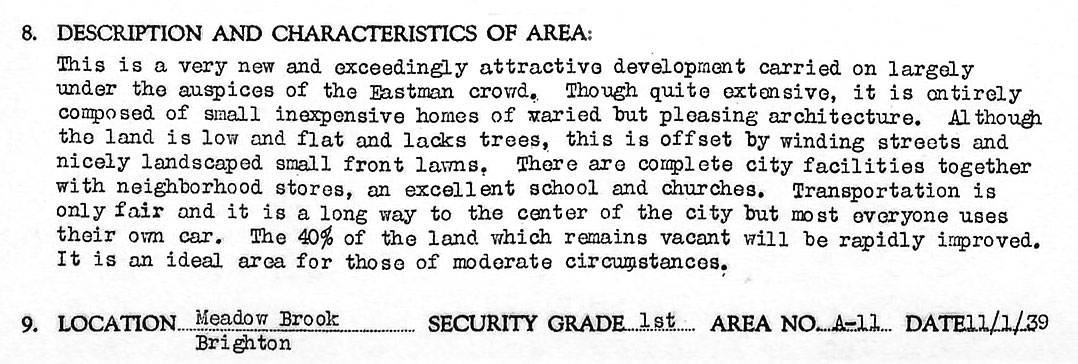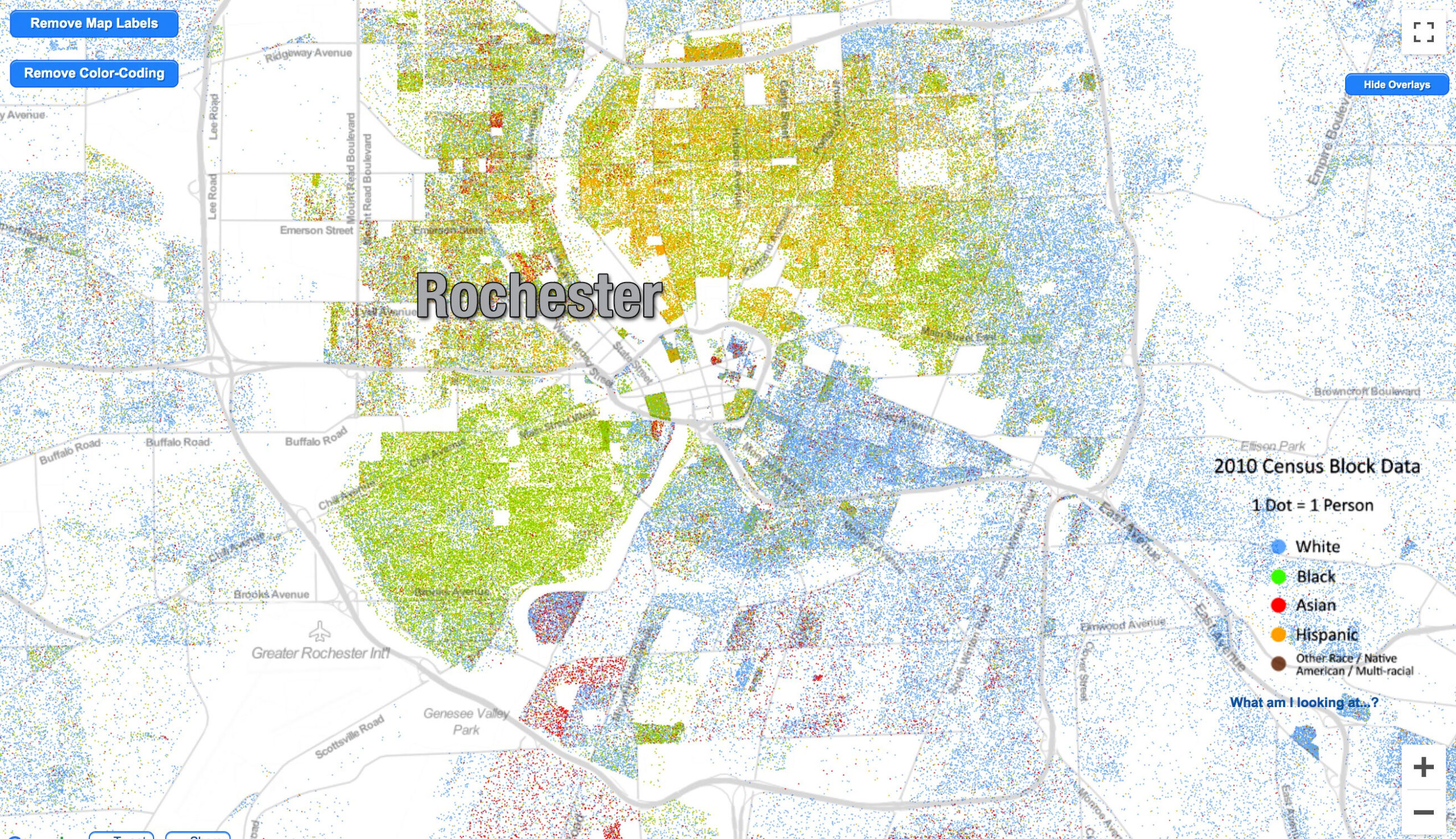If racial covenants have not been legally enforceable since 1948, how could they impact residential patterns today?
How could exclusionary Meadowbrook deed restrictions in the past have contributed to broader patterns of racial and economic segregation that endure today?
A must-read recent report, Confronting Racial Covenants: How They Segregated Monroe County and What to Do About Them, provides an essential overview of racial covenants in Brighton, Pittsford, and areas of the city of Rochester, and their enduring effects. Meadowbrook’s racial covenant is an important part of this story. Our neighborhood’s 1929 racial covenant, legal until 1968, was part of a deliberate attempt to create a particular kind of neighborhood based on racial, religious, and class-based exclusions. The covenants combined with federal lending practices to produce enduring structural racial and economic inequality, in Rochester and around the country. Given the centrality of Meadowbrook to Brighton, past and present — a hub around which Brighton’s public secondary schools, courthouse, police station, firehouse, and town library all were situated — might it be even more urgent to render visible this history and identify what ways its legacies endure?

Meadowbrook’s Restrictive Covenant XII Excluding “Colored” People
Meadowbrook’s racial covenant was incorporated into every deed in 1929 in perpetuity; the only method for revising this or any other restriction is by the agreement of 3/4 of the houses included in the tract. It specifically restricted sale to and occupation of any lot or house by “a colored person.” While the designation “colored” referred specifically to Blacks, in practice it was at times used to exclude others who were seen as “not white”. Click here to read the Meadowbrook deed restrictions in full.
Racial covenants shaped who could and could not purchase or rent property in Meadowbrook until the 1970s. Although a 1948 Supreme Court ruling said that racial covenants could not be legally enforced, the decision held that the racial exclusions were indeed legal. Ongoing de facto enforcement of housing exclusions was therefore permitted through “gentlemen’s agreements,” marketing, and realtor practices for several decades as has been described in Rochester, including during the mid-1960s when people left Rochester for the suburbs in the wake of urban unrest. The Fair Housing Act of 1968 finally prohibited housing discrimination but even then, discriminatory practices continued.
Meadowbrook is a textbook example of how racial covenants were combined with a broader set of legal regulations, economic policies and social practices with enduring economic consequences. Meadowbrook’s development occurred alongside the establishment of the nationwide Federal Housing Administration (FHA), which subsidized developers and insured loans for neighborhoods outside urban areas (many of which included racial covenants), while refusing to insure loans in and near neighborhoods described as “definitely declining” or “hazardous” (most of which were either neighborhoods that were already associated with non-whites or with working poor). This practice was called redlining, taking its name from the shaded red areas on maps that agents working with the federal government’s Home Owner’s Loan Corporation in 1935-1940 designated as “hazardous,” as compared to green areas designated as “desirable.”
Racial covenants worked in tandem with the logics of the FHA maps: “Infiltration” or “shifting” population dynamics were one important metric for the designation status, where A- and B-graded neighborhoods had “newcomers of the same type” or of the same “class”, while lower grades (C and D) were often assigned because of increasing populations of “Italians,” “Hebrews,” or “Negroes”. This meant that racial covenants that might have been listed as applying to “colored” were often in practice used to exclude others (Jews, Italians) who were widely seen as threatening to property values.
Books and articles attest to the fact that urban/suburban segregation nationwide did not happen by accident, but rather “by design“. Visual maps such as the Mapping Prejudice Project in Minneapolis or Mapping Segregation in Washington, DC show similar dynamics in other cities.
Meadowbrook and Redlining:
Where “careful restriction” provides “desirable neighbors”
We can see the localized dynamics of these area descriptions and redlining in Rochester and specifically Meadowbrook. The FHA maps from 1939/1940 show that the A (“best”) and B (“still desirable”) designations were all located in what became the suburbs. All areas around the urban center were designated “definitely declining” (C) or “hazardous” (D). Meadowbrook, area A11 in the Rochester map, was described as “a very new and exceedingly attractive development, one of the 10% graded A / “best”, and shaded in green.


In Meadowbrook, as nationwide, the area descriptions linked desirability (of living and of investing there) to particular race, class, and family configurations. Meadowbrook was desirable precisely because it was near churches (meaning people were presumed to be practicing Christians), was a “long way to the center of the city” with “only fair” transportation, intended for people with “their own car (meaning Meadowbrook residents were insulated from the poor urban residents who could not easily get there), and had “an excellent school” (meaning it was designed for heterosexual couples with kids). The description of Meadowbrook as “carried out largely under the auspices of the Eastman crowd” underscored that the culture was designed for and by an insular group of mostly white-collar men with housewives at a company whose leader, while a great philanthropist in the region, has been critiqued for building a company culture that excluded Blacks.
Meadowbrook’s racial covenants were not mentioned overtly in the Home Owner Loan Corporation’s area description, yet the population was described as “newcomers are of the same type.” At the same time, the promotional booklet for our neighborhood in the 1930s emphasized that “children will have plenty of nice companions to play with, for careful restriction in Meadowbrook provides very desirable neighbors.” Put bluntly, the “exceedingly attractive” and “desirable” nature of Meadowbrook were thinly-veiled code for white, Christian, middle-class heteronormative nuclear families, excluding other races, ethnicities, religions, economic classes, and family configurations. The Meadowbrook Neighborhood Association was set up in such a context.
By contrast, urban neighborhoods designated “declining” or “hazardous” were often described as such because of having “Italians and Hebrews” (plot D1) moving into the area, and the descriptions dripped with racial and class-based biases that prompted these negative designations: “Negroes have come into the area and today it is the poorest section of the entire city” (plot D5); “Older families have moved out and been replaced by Italian. It will no doubt continue to decline further as time goes on” (plot C14); “Appeal is entirely to the laboring classes who cannot afford better” (plot D2); “There is almost no pride of ownership” (plot D3). Overall the FHA maps described areas as thriving or lacking based on raced and classed prejudices. These descriptions were then used to justify financial investment in white areas and disinvestment elsewhere.
Enduring Legacies:
Structural Racism and Economic Inequality
Our Meadowbrook racial covenants are thus one important part of the broader Rochester story of structural racism and systemic inequality. For decades, racial covenants combined with redlining practices to direct upwardly mobile whites to homeownership in segregated “desirable” neighborhoods, while excluding non-whites from the postwar housing boom, and restricting them to segregated urban areas already marked by concentrated poverty. Notably, this occurred during the period when Rochester’s black population increased from approximately 3,000 in 1940 to nearly 50,000 in 1970. Racial covenants combined with government-sanctioned lending practices were thus one central way in which many white Rochesterians were helped to accumulate wealth through home ownership over generations, while Black Rochesterians were actively prevented from doing so. Nationwide, between 1934 and 1962, 98% of FHA-insured loans went to white borrowers. It wasn’t until the 1970s that the legal basis for the practice of redlining was eliminated nationwide.

Racial covenants and redlining correlate with patterns of economic inequality, racial segregation, political violence and health disparities today. Patterns of racial segregation from the 2010 census are hauntingly consistent with the FHA redlining maps, pictured above. Rochester’s concentrated poverty in formerly-redlined areas — a function of decades of disinvestment — is particularly acute; it ranked 3rd in overall poverty among the nation’s 75 largest metropolitan areas. With concentrated racial segregation and poverty comes food insecurity, housing and schooling instability, and violence. In 2020, the largest gap in spending between urban and adjacent suburban school districts in the country was between Rochester and Penfield. Rochester Police Department officers, in a longstanding pattern, live outside the city, while the people they surveil and detain are from historically redlined areas: for example, both Clinton/Joseph/Hudson Avenues, a site of urban unrest in the 1964 uprisings, and the area of Jefferson and McCree, where Daniel Prude was killed in March 2020, were deemed hazardous in the 1939 mapping and were redlined. A recent report shows how COVID-19 has disproportionately impacted formerly redlined neighborhoods.
Within Brighton, much has changed, to be sure, and the town and Meadowbrook are much more heterogeneous in ethnicity, religion, nationality, and family configuration than a few generations ago. Notably, Temple B’rith Kodesh moved to its current location not far from Meadowbrook in 1962, and Chabad Rochester, adjacent to Meadowbrook, was established in 1981. (Click here for more history of faith communities in Brighton.) Despite this greater diversity, Brighton today remains 76% white and only 6-7% Black. Yet housing exclusions persist in Brighton, particularly along economic lines. And while the town has enacted a law that makes it illegal for landlords to discriminate against potential tenants based upon the source of income, no Brighton landlords have opted into a federally funded program that subsidizes rent for eligible low-income residents (i.e., Housing Choice Vouchers, formerly known as Section 8).
While Meadowbrook is clearly more welcoming today to neighbors of all races, faiths, backgrounds and family types than in the days of its founding, there remains much to be done to roll back the structural legacies of exclusion that we have inherited.
For more information, see:
- Anti-Racist Curriculum Project:
https://pathstone.foundation/antiracist-curriculum-project/ - 540 West Main: Anti-Racist Education and Events:
https://540westmain.org/ - Rochester Museum and Science Center Howard W. Coles Collection:
http://collections.rmsc.org/Library/ColesHoward_findingAid.pdf - Rochester City Library, curated section on Understanding the Black Experience in Rochester:
https://roccitylibrary.org/understanding-black-experiences/historical-context/
Segregated by Design
This video summarizes the book titled The Color of Law. Narrated by the author, Richard Rothstein.
Racist Policies and Resistance in Rochester, NY
A presentation by Shane Wiegand, 8/20/2020. Shane is a teacher in the Rush-Henrietta school district whose research and work with students has helped surface and detail a great deal of the local story about racial covenants and other forms of systemic racism.
This page was written by Kristin Doughty, and last updated in the spring of 2021.
For further updates, please visit the new CORD website: https://www.meadowbrookcord.com
